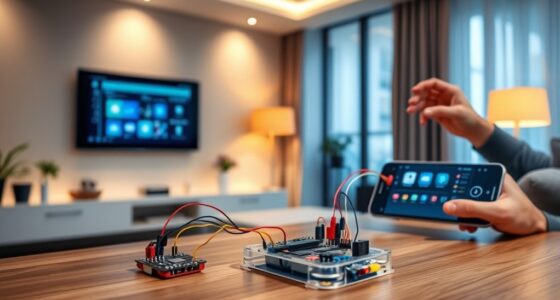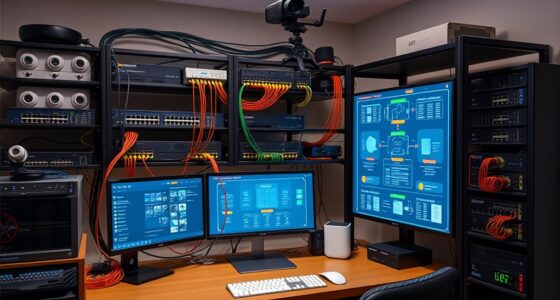To start with smart bulbs and switches, choose compatible devices that work with your existing smart home ecosystem like Alexa, Google, or Apple. Install them just like traditional fixtures, then connect them to your Wi-Fi using the app instructions. Use voice commands, your phone, or automation to control the lighting easily. With simple setup tips and automation ideas, you’ll discover how smart lighting can enhance comfort and save energy—keep exploring to learn more about making your home smarter.
Key Takeaways
- Select compatible smart bulbs or switches that work with your existing smart home ecosystem (Alexa, Google, Apple).
- Install devices by replacing traditional bulbs or switches, then connect them to Wi-Fi via the manufacturer’s app.
- Follow setup instructions to link devices to your app and configure controls like voice commands or schedules.
- Use voice assistants or apps to turn lights on/off, dim, or change colors for added convenience.
- Automate lighting routines based on time, occupancy, or environmental cues to maximize energy efficiency and comfort.

Smart lighting has revolutionized how you illuminate your home or workspace by offering greater control, convenience, and energy efficiency. With the right setup, you can turn lights on or off, dim them, or change colors using just your voice or a smartphone app. This level of control makes managing your lighting more intuitive and effortless. When you incorporate voice control into your smart lighting system, you eliminate the need for physical switches, allowing you to adjust lighting with simple commands like “Alexa, turn on the living room lights” or “Hey Google, dim the bedroom lights.” It’s a hands-free experience that seamlessly fits into your daily routine, especially when your hands are full or you’re relaxing on the couch.
Energy efficiency is one of the most significant benefits of smart lighting. Traditional incandescent bulbs waste a lot of energy, often staying on longer than needed. Smart bulbs, on the other hand, consume less power while providing the same, if not better, illumination. You can schedule lights to turn off automatically when not in use or during specific times of the day, reducing unnecessary energy consumption. Many smart bulbs also allow you to set brightness levels, so you’re not using more light than you need. This precise control helps cut down on electricity bills and reduces your carbon footprint. Additionally, with features like adaptive lighting, your smart system can adjust brightness based on ambient light conditions, further enhancing energy efficiency without sacrificing comfort.
Getting started with smart bulbs and switches is straightforward. First, choose compatible devices that work with your existing smart home ecosystem—whether that’s Amazon Alexa, Google Assistant, or Apple HomeKit. Once you have your bulbs or switches, install them just like traditional lighting fixtures, and then connect them to your Wi-Fi network through a dedicated app. Many smart bulbs come with step-by-step instructions, making setup simple even if you’re new to smart home tech. After installation, you can control your lights via voice commands, the app, or set automations and schedules. For example, you might automate your hallway lights to turn on at sunset or schedule bedroom lights to gradually brighten in the morning, mimicking natural sunrise. Incorporating high-quality projectors into your home theater setup can further elevate your entertainment experience, complementing your smart lighting system perfectly.
Incorporating voice control and scheduling features not only enhances convenience but also optimizes your energy use. As you become more familiar with your smart lighting system, you’ll discover new ways to customize your environment—creating the perfect ambiance for any occasion while saving energy. With just a few simple steps, you can transform your space into a smarter, more efficient, and more comfortable environment, all with minimal effort.
Frequently Asked Questions
Can Smart Bulbs Operate Without Wi-Fi?
Smart bulbs typically require Wi-Fi for remote control and automation, so they can’t operate fully without it. However, some models use Bluetooth connectivity, allowing you to control them nearby without Wi-Fi. If Wi-Fi dependency concerns you, look for Bluetooth-enabled smart bulbs. Keep in mind, Bluetooth limits your control range, but it’s a good alternative if you want local control without relying on Wi-Fi.
Are Smart Switches Compatible With All Types of Bulbs?
You wonder if smart switches work with all bulb types. Compatibility depends on the switch type and the bulbs you use. Most smart switches are designed for standard bulbs like LEDs and incandescents, but some may not support certain dimmable or specialty bulbs. Always check the switch’s bulb compatibility and guarantee it matches your bulb types to avoid issues. This way, you get seamless operation and reliable control over your lighting.
How Secure Is My Smart Lighting System From Hacking?
Your smart lighting system is generally secure if you use strong encryption protocols like WPA3 and regularly update your firmware. These measures help prevent hacking by protecting your network and device data. While no system is completely hack-proof, practicing good cybersecurity habits, such as changing default passwords and enabling two-factor authentication, markedly enhances hacking prevention. Stay vigilant and keep your system’s security features current for ideal protection.
Can Smart Lighting Reduce Energy Bills Significantly?
Like a wise spender, smart lighting can cut your energy bills considerably. With features like scheduling and motion detection, you optimize your energy savings and reduce costs effortlessly. You control when lights are on, preventing waste and lowering your electricity consumption. This smart approach to lighting not only boosts convenience but also leads to substantial cost reduction over time, making your home more efficient and eco-friendly.
What’S the Lifespan of Most Smart Bulbs?
Most smart bulbs typically last around 25,000 to 50,000 hours, offering impressive bulb durability. You’ll find their lifespan comparison favorable against traditional bulbs, which usually last about 1,000 hours. This means you won’t need to replace them frequently, saving you time and money. Keep in mind, factors like usage and brand can influence lifespan, but generally, smart bulbs are built to last for several years.
Conclusion
Now that you’ve explored smart bulbs and switches, you’re ready to transform your space with just a tap or voice command. Imagine your home’s lighting effortlessly adapting to your mood, yet staying simple enough for anyone to use. It’s like having a high-tech assistant that’s both futuristic and familiar. Embrace the ease of smart lighting—because the future isn’t just bright, it’s smarter, and it starts today with you.










